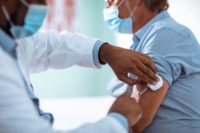The ideal time to respond to a medical emergency is well before the emergency happens. Establishing policies in advance, publishing those policies in the employee manual or posting them on the company intranet, training individuals in the appropriate protocols, and having necessary equipment in place, all ensure that the emergency response to medical emergencies is as effective as possible. Since each company has its own unique risks, recommendations will need to be adapted to fit the specific work environment.
What constitutes a medical emergency? The answer is any acute illness or injury that poses a threat to the life or well-being of the individual. Below is a truncated list of warning signs from the American College of Emergency Physicians:
• Bleeding which cannot be controlled
• Shortness-of-breath
• Change in mental status or alertness
• Chest pain
• Choking
• Loss of consciousness or dizziness
• Head or spine injury
• Severe vomiting
• Sudden, severe pain
• Acute injury (motor vehicle accident, burns, near drowning, etc.)
• Ingestion of poison
• Suicidal or homicidal intention
OSHA requires prompt first aid
OSHA requires companies to provide prompt first aid, which means having first aid supplies and trained first aid providers available if no treatment facilities are located nearby. There should be “medical personnel available for advice and consultation,” and “facilities for quick drenching or flushing of the eyes and body” in the event of exposure to “corrosive materials” (29 CFR 1910.151).
According to the OSHA Small Business Handbook, employees responsible for emergency medical response should be given training in first aid. OSHA encourages companies to train at least one employee in first aid and cardiopulmonary resuscitation (CPR). If companies provide an Automated External Defibrillator (AED) in the workplace, a sufficient number of their employees should be trained in its use.
OSHA requires that employers train any employees with potential exposure to blood or other potentially infectious material under the Bloodborne Pathogen Standard (29 CFR 1910.1030(g)(2)). An employee whose duties involve providing first aid and medical assistance falls under this standard. These emergency medical responders should also be knowledgeable about bloodborne pathogens and the use of PPE (personal protective equipment) to prevent exposures. They should be offered Hepatitis B vaccinations as well.
Defining a “nearby” treatment facility
Asked to clarify the meaning of “nearby” treatment facilities, OSHA stated that there should be emergency care available within 3-4 minutes of the workplace where the potential for life threatening accidents exists (for example, suffocation or electrocution). Offices and other workplaces with a lower risk of injury have up to 15 minutes to reach treatment facilities. Certain industries with remote work environments, such as electric power and logging, are required to provide first aid training to their employees.
Larger companies may have an on-site medical staff to deal with medical emergencies. Smaller companies should assign an individual to keep medical supplies up-to-date and restocked, and to act as the company contact in the event of a medical emergency. Phone numbers of the nearest emergency department and ambulance service should be readily available. Companies should have a plan in place which specifies who and when to call in the event of a medical emergency.
Call 911
When faced with a life-threatening medical emergency at work, the first action should be to call 911. It is better to err on the side of caution by calling 911, than to delay and put an individual’s life at risk. If the victim is unresponsive, the American Heart Association recommends that CPR be started as soon as possible. The injured person should not be moved unless the area presents a safety risk to the injured person and/or the first responders. An individual with a suspected neck injury should not be moved in order to avoid potential damage to the spinal cord
When an AED is available, it should be utilized as quickly as possible. Every minute counts when resuscitating an individual who has had a sudden cardiac arrest. Survival rates have been as high as 90% when an AED has been used in the first minute of sudden cardiac arrest. The rates decrease by 7-10% every minute after that.
Setting up an AED program is beyond the scope of this article. Suffice it to say purchasing an AED is only the first step in the process, and that a comprehensive program for AED maintenance (including battery replacement), employee training, and physician oversight is essential. Ideally, AEDs should be placed in areas where employees congregate, such as cafeterias or break areas. There must be regular first aid and AED refresher training for employees to help maintain skills.
First aid training
For non-cardiac injuries, basic first aid should be provided. First aid kits should be available. The ANSI Z308.1-2009 standard specifies what items the first aid kits should contain. OSHA recommends that first aid training should prepare providers to assess the injury scene to determine:
• General safety of scene
• Sequence of accident causing injury
• Estimate of how many individuals were injured
• Identification of people able to help
• Initial assessment of injured individuals with regard to airway, breathing, circulation and degree of bleeding
• Secondary assessment about injuries
OSHA requires that first aid training emphasizes the importance of following universal precautions in order to avoid exposure to potentially infectious bodily fluids. Gloves, personal protective equipment, and appropriate containers for disposal of sharp items must be easily accessible.
Benjamin Franklin said: “By failing to prepare, you are preparing to fail,” and “an ounce of prevention is worth a pound of cure.” Companies should take heed.
References
Blakey, Carol. ANSI Requirements for first aid kits revised. http://blog.nelsonjameson.com/ansi-requirements-for-first-aid-kits-revised. May 27, 2010.
Maurer, Roy. “Workplace AED, Response Programs Can Save Lives”, http://www.shrm.org/hrdisciplines/safetysecurity/articles/pages/workplace-aed-response-save-lives.aspx. Society for Human Resource Management, 9/1/2014.
https://www.osha.gov/pls/oshaweb/owadisp.show_document?p_table=STANDARDS&p_id=10499
OSHA Fact Sheet, Planning and Responding to Workplace Emergencies, https://www.osha.gov/OshDoc/data_General_Facts/factsheet-workplaceevergencies.pdf
Recognizing Medical Emergencies, Medline Plus, National Institutes of Health, U.S. National Library of Medicine, http://www.nlm.nih.gov/medlineplus/ency/article/001927.htm. Updated 1/11/2013.
Small Business Handbook, Occupational Safety and Health Administration, https://www.osha.gov/Publications/smallbusiness/small-business.html
U.S. Dept. of Labor, Occupational Safety and Health Administration , We Can Help, https://www.osha.gov/pls/oshaweb/owadisp.show_document?p_table=INTERPRETATIONS&p_id=25627
U.S. Dept. of Labor, Occupational Safety and Health Administration , We Can Help, https://www.osha.gov/pls/oshaweb/owadisp.show_document?p_table=INTERPRETATIONS&p_id=25741







